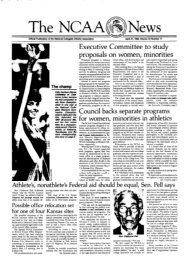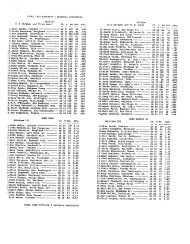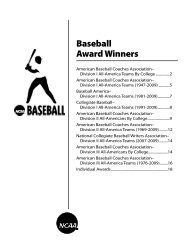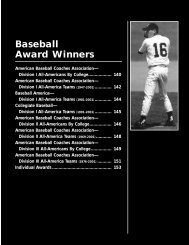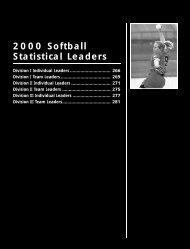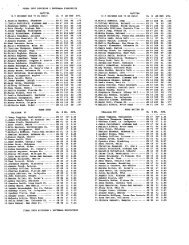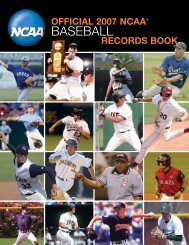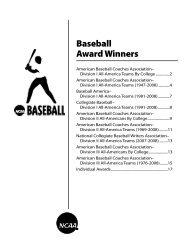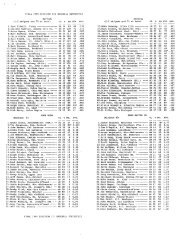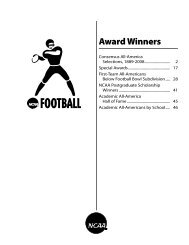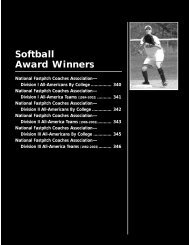The NCAA News
The NCAA News
The NCAA News
Create successful ePaper yourself
Turn your PDF publications into a flip-book with our unique Google optimized e-Paper software.
n Comment<br />
Editor-in-&ii<br />
P. David Pickle<br />
Managing &or<br />
Jack 1. Copeland<br />
Assistant adii<br />
Vikki K. Watson<br />
Ediil and<br />
odv&ising as&ant<br />
Ronald D. Man<br />
<strong>The</strong> <strong>NCAA</strong> <strong>News</strong><br />
17 Guest didal<br />
<strong>The</strong> Comment sec-<br />
tion of <strong>The</strong> <strong>NCAA</strong><br />
<strong>News</strong> is offered as a<br />
page of opinion. <strong>The</strong><br />
views do not necessar-<br />
ily represent a con-<br />
sensus of the <strong>NCAA</strong><br />
membership.<br />
Current eligibility rule<br />
serves as a motivator<br />
BychfistopherB.Ms<br />
EXECUTIVE DIRECTOR, KNK;Hl FOUNDATION<br />
COMMISSION ON IlWERCOLlEGlAlE ATHLETICS<br />
<strong>The</strong> recent commentary by Alonzo Free-<br />
man (<strong>The</strong> <strong>NCAA</strong> <strong>News</strong>, November 14) is a<br />
remarkably eloquent and inspiring account of<br />
one young man’s struggle to overcome a bit-<br />
ter, personal disappointment and replace it<br />
with a dream. His life, it seems, is a patent<br />
rejection of Herbert Spencer’s theory that<br />
“once you fail, you’re down for good.”<br />
Mr. Freeman’s goal of graduation from<br />
Arkansas State University is applaudable and<br />
worthy of our support and encouragement;<br />
however, his proposal for an extta year of eli-<br />
gibility for “partial qualifiers” is not Under<br />
the current system, the fourth year of eligibili-<br />
ty selves as an important means of motivating<br />
prospective student-athletes during their sec-<br />
ondary-school years. Changing this rule<br />
would send a very wrong message.<br />
A fair and viable solution to Mr. Freeman’s<br />
dilemma can be found in the first report of<br />
the Knight Foundation Commission on Inter-<br />
collegiate Athletics, “Keeping Faith with the<br />
Student-Athlete.” Among other recommenda-<br />
tions, Knight Commission members offered<br />
this alternative:<br />
“Athletics scholarships should be offered<br />
for a five-year period. In light of the time<br />
demands of athletics competition, we believe<br />
that athletics scholarship assistance routinely<br />
should cover the time required to complete<br />
the degree, up to a maximum of five years.<br />
Moreover, the initial offer to the student-ath-<br />
lete should be for the length of time required<br />
to earn a degree up to five years, not the sin-<br />
gle year now mandated by <strong>NCAA</strong> rules. <strong>The</strong><br />
only athletics condition under which the five-<br />
year commitment could be broken would be<br />
if the student refused to participate in the<br />
sport for which the grant-in-aid was offered.<br />
Otbexwise, aid should continue as long as the<br />
student-athlete remains in good standing at<br />
the institution.”<br />
This approach retains the “fourth year” as<br />
a motivational tool for precollege preparation<br />
while removing a major hurdle from the path<br />
of the “partial qualifier” who is intent upon<br />
college graduation.<br />
What better way for Arkansas State<br />
University to honor the hard work and deter-<br />
mination of Alonzo Freeman than to draft<br />
legislation based upon this recommendation<br />
and submit it for consideration at the 1996<br />
<strong>NCAA</strong> Convention? What better way for all of<br />
us to “keep faith” with our student-athletes<br />
and our educational principles than to sup<br />
port this legislation next January?<br />
More skill instruction desirable<br />
Current <strong>NCAA</strong> legislation (Bylaw<br />
17.5.5.2) limits a student-athlete’s par-<br />
ticipation in strength and conditioning<br />
activities to a total of eight hours per<br />
week outside the playing and practice<br />
season.<br />
In addition, student-athletes are not<br />
permitted to participate in such activi-<br />
ties for more than two hours per day<br />
and must receive one complete day off.<br />
A proposal by the Atlantic Coast<br />
Conference (No. 20 in the Official<br />
Notice for the 1995 Convention) seeks<br />
to amend the current rule to include<br />
individual skill development sessions.<br />
Specifically, this proposal would allow<br />
coaches to supervise student-athletes in<br />
sport-specific skill training during not<br />
more than two of the eight hours cur-<br />
rently permitted for strength and con-<br />
ditioning activities. (This proposal also<br />
would limit these skill sessions to two<br />
student-athletes at any one time.)<br />
In effect, this would leave six hours<br />
for strength and conditioning activities.<br />
<strong>The</strong> rationale for this proposal is that<br />
student-athletes want to improve their<br />
abilities in their particular sport rather<br />
than spend extra time on strength and<br />
conditioning.<br />
<strong>The</strong>re is no question that perfecting<br />
sports-specific skills will have a greater<br />
impact on a student-athlete’s perfor-<br />
mance than either strength training or<br />
conditioning activities. <strong>The</strong> question<br />
then becomes, “Is six hours per week<br />
enough time to produce improvements<br />
in muscular strength and cardiovascu-<br />
lar conditioning?”<br />
Science has been unable to discover<br />
one strength and conditioning method<br />
that is superior to another. Research has<br />
0 Opinions<br />
cl LetBer<br />
shown only that there are a variety of<br />
methods that can increase muscular<br />
strength and cardiovascular ability. One<br />
of the greatest misconceptions in the<br />
strength and conditioning profession is<br />
that an increase in the volume of the<br />
activity produces better results. <strong>The</strong> truth<br />
is that more isn’t necessarily better when<br />
it comes to strength and conditioning<br />
activities.<br />
<strong>The</strong> most important factor in deter-<br />
mining the response from strength and<br />
conditioning activities is the student-ath-<br />
lete’s level of intensity or effort. An<br />
inverse relationship exists between<br />
intensity and the duration of the activ-<br />
ity: As the time of an activity increases,<br />
the level of intensity decreases. Stated<br />
otherwise, a student-athlete cannot train<br />
at a high level of intensity for long peri-<br />
ods of time.<br />
Essentially, the primary purpose of<br />
strength and conditioning activities is<br />
to reduce a student-athlete’s risk of<br />
injury. Six hours of time each week is<br />
more than enough to prepare a student-<br />
athlete for the rigors of competition. A<br />
number of different possibilities exist<br />
to schedule strength and conditioning<br />
activities during a weekly six-hour time<br />
frame. For example, a productive one-<br />
hour strength training workout can be<br />
performed three times per week on<br />
nonconsecutive days (for example,<br />
Monday, Wednesday and Friday) and a<br />
one-hour conditioning session can be<br />
done on alternate days (for example,<br />
Tuesday, Thursday and Saturday).<br />
Limiting strength-training workouts<br />
and conditioning sessions to one hour<br />
has an important physiological basis.<br />
Carbohydrates are the body’s preferred<br />
fuel source during intense exercise.<br />
Most individuals exhaust their carbo-<br />
hydrate stores after about one hour of<br />
intense exercise. As such, both strength<br />
training and conditioning sessions<br />
should be limited to one hour.<br />
Strength and conditioning activities<br />
should emphasize the quality of the<br />
workout rather than the quantity of the<br />
workout. <strong>The</strong> most efficient program is<br />
one that produces the maximum possi-<br />
ble results in the least amount of time.<br />
Coaches who insist, encourage or<br />
coerce their student-athletes to invest<br />
excessive amounts of time in strength<br />
and conditioning activities beyond that<br />
which is needed to strengthen the mus<br />
culoskeletal system against injury are<br />
providing a tremendous disservice to<br />
them.<br />
A six-hour restriction on strength and<br />
conditioning activities will encourage<br />
strength coaches to finally let go of the<br />
traditional competitive-weightlifting-<br />
inspired programming and seek more<br />
practical and time-efficient methods for<br />
training their student-athletes. Rather<br />
than waste inordinate amounts of time<br />
in the weight room learning absolutely<br />
useless competitive weightlifting skills,<br />
student-athletes will have more time to<br />
practice and perfect sportsspecific skills<br />
that will be used in their competition.<br />
Matt Brzycki<br />
Coordinator of Health Fitness,<br />
Strength and Conditioning Programs<br />
Princeton Univexsity<br />
Suit brought more exposures, less money<br />
James Frank, commissioner<br />
Southwestern Athletic Conference<br />
Former <strong>NCAA</strong> president<br />
New Orleans limes-Picayune<br />
“(W)hen Oklahoma and Georgia sued the <strong>NCAA</strong> on prop<br />
etty rights and accused the <strong>NCAA</strong> of being a monopoly, (that)<br />
ultimately did away with the <strong>NCAA</strong> television plan as we knew<br />
it When it got to the Supreme Court, they ultimately ruled in<br />
favor of the people who sued the <strong>NCAA</strong>, and that changed<br />
the television situation forever. I will go to my grave believ-<br />
ing it was greed - the Oklahomas and Ceorgias of this world<br />
felt that if they were not governed by the <strong>NCAA</strong> in terms of<br />
television, they’d be on television every week, and they’d get<br />
all those rights fees. <strong>The</strong>y got on television a little bit more,<br />
but the rights fees dropped, and they’re still not getting what<br />
they were getting 10 years ago.”<br />
Coackiyl<br />
George Raveling, former men’s basketball coach<br />
Universi d Souhm California<br />
10s Ange 7 es limes<br />
“<strong>The</strong> most fun in coaching I ever had was when I was at<br />
Washington State, because there was a different set of cir-<br />
cumstances. <strong>The</strong> rules were different, the kids were different<br />
and the expectations were different. It was just fun to coach<br />
then. You really were a coach then. Today, it is coach, slash-<br />
slash-slash-slash. Coaching is the easiest part Now, you have<br />
to deal with so many other things, from <strong>NCAA</strong> rules changes<br />
to public relations....<br />
“If my son (Mark) came up to me and asked me whether<br />
he should get into coaching or not, I would tell him, ‘Don’t<br />
do it’ <strong>The</strong> reason is that everything is so much different today.<br />
People only care if you win, and unfortunately, the real vic-<br />
tories come off the court Seeing a kid grow like (the University<br />
of Southern California’s) Mark Boyd, who had never slept in<br />
his own bed until he got here. To see him grow from a boy<br />
to a man, those are the real victories.”<br />
kmy Switzer, coach<br />
Dollas cowboys<br />
<strong>The</strong> B&more Sun<br />
On the differences between colbge and professional coaching:<br />
“It’d take two hours to talk about that. I’d first start with<br />
(dealing with) the <strong>NCAA</strong>. I can start with 120 players vs. 50.<br />
I can start with every crisis and personal problem an athlete<br />
has (in college), he comes to see me. He doesn’t waIk through<br />
my door to say, ‘Coach, I made an A on my test’, or ‘how’s<br />
your day going.’ He comes in there with a problem I’ve got<br />
to deal with.<br />
“<strong>The</strong>re’s tremendous pressure day to day, academics, I can<br />
go on and on and on. I don’t even want to talk about it. But,<br />
hey, I don’t have those problems here. I’m only dealing with<br />
50 (players), they’re professionals and it’s ajob for them.”<br />
Mike Lopresti, columnist<br />
Gannet/ <strong>News</strong> Service<br />
“It remains...a harsh land out there for the men in the head-<br />
phones. <strong>The</strong> popular outcry of anguish these days is over the<br />
lack of a playoff, as if this besmirches the game. But much<br />
more embarrassing for major college football is what has<br />
happened to the job of coaching it<br />
“Fed by inane call-in shows, fueled by ridiculous expecta-<br />
tion, flamed by media, this fire is out of control. We talk of<br />
honesty and integrity, but reward only victory.”<br />
Anson Dorrance, women’s soccer coach<br />
University of North Carolina, Chapel Hill<br />
Chicago Tribune<br />
“In athletics you want to win forever, you want constant<br />
renewal. Flowers remind you of the ephemeral quality of suc-<br />
cess. You must remember what it took to get you there.<br />
Flowers die shortly and it’s the same in athletics. You must<br />
recommit yourself.”



